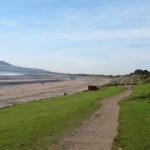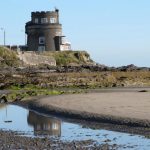‘Well, I’d say we’ve the day for it.’ From the sea wall ramp at Portmarnock, Colette Farrelly gestured out wide towards the east. How right she’d been to get me out here good and early. Could there ever have been a more perfect early morning along the Velvet Strand? The long green shoulder of Lambay and the hunched lump of Ireland’s Eye rose from a brilliantly coruscating sea, silky and ice blue, where Howth Head poked out dark and bulky from its isthmus. The low sun poured from a cloudless sky like honey over sands and dunes. Strollers strolled and runners ran, few and far between at this hour. And three riders clopped their horses slowly along the tide line in perfect profile, straight from the palette of Jack Vettriano.
‘Actually it was Nathanial Hone who really caught this fantastic light and huge sky when he was living at Malahide late in the 19th century,’ said Colette. ‘Do you know his paintings?’ I didn’t, but I determined on the spot to find out all about him. That’s the effect that Colette, a bundle of enthusiasm and by-the-way knowledge, has on you when you join one of her sort-of-historical, kind-of-geological walks and talks along this, her native slice of coast.
The Malahide photographic mafia were out with us today – ‘Deirdre, Harry, Helen, Pamela,’ they introduced themselves. They couldn’t have picked a better morning, with sharp-cut shadows and the clearest of light all over everything. It was tempting to turn south and wander the three gently curving miles of the Velvet Strand to its vanishing place at Portmarnock Point, but we were bound north around the curve of the low cliffs.
The big strand possesses a big history. It was from these firm flat sands that Charles Kingsford-Smith took off on 23 June 1930 in his Fokker Trimotor ‘Southern Cross’ to acomplish the second east-west Atlantic air crossing in history (the first had been in 1928). Kingsford-Smith had a crew with him; but when Jim Mollison – husband of aviation pioneer Amy Johnson – set off from the Velvet Strand on 18 August 1932 in his De Havilland Puss Moth biplane ‘Heart’s Content’, he faced the dangers and fears of the crossing alone. When Mollison landed at New Brunswick, 31 hours and 20 minutes later, he’d achieved the first solo east-west Atlantic crossing by air. It was a stunning, incredibly brave feat, but Mollison’s name goes unremembered these days.
Razor shells, cockles and scallops crunched underfoot as we walked the shore and clambered across up-tilted rock plates crusted with mussels and barnacles in uncountable millions. Where this rough dull gold coating fell away, the slate-grey of the limestone showed through. It’s a jumbled geology here – quartz and sandstone on Howth Head, volcanic porphyry on Lambay (Mesolithic folk quarried it for axe-heads), and limestone along the mainland shore, shot through with dramatic veins of pure white quartz.
Up at the point a Martello tower stared out to sea. The grim little drum-shaped forts, built in a string along Ireland’s coasts against French invasion at the dawn of the 19th century, might not have made the greatest fortresses. But they did furnish James Joyce and scores more romantics with damp, draughty dream towers.
‘Something special over here,’ called Colette from among the rocks. It was the fossilised imprint of a crinoid, a graceful sea lily, spread in the grey limestone in the shape of a dish-mop left out to dry. Nearby, white glittering circles showed where the hinged shells of brachiopods had petrified. The quartz veins marched away in straight lines, scored across the dark rocks and cliffs in a geologic of their own. Oystercatchers piped from the tideline, and three seals wallowed sensuously in the shallows.
We passed the diving board at High Rock with its weed-green iron ladder, the tiny sandy bathing beach at Middle Rock, and the stark old Norman keep on the sea wall at Low Rock. Over the ribbed sands to Malahide, and a glimpse of the old wooden jetty where cod fishers would land their catch. ‘We have a local saying,’ Colette remarked, ‘her mouth was open like a Malahide cod.’
How perfect it would have been to win back the clock and see a Malahide cod yawl sailing up the Broad Meadow River to the jetty. But I’ll have to visit Nathaniel Hone in the National Gallery if I want to catch a glimpse of one of those.
WAY TO GO
MAP: OS of Ireland 1:50,000 Discovery 50; downloadable map at http://www.visitdublin.com/pdf/iWalk10.pdf
TRAVEL:
Rail (www.dart) to Portmarnock station (20 mins walk from seafront).
Bus (www.dublinbus.ie) 32A or 32B to Portmarnock Country Club Hotel.
Road: M50, M1 (Jct 3), N32, R106 to Portmarnock car park beside Country Club Hotel.
WALK DIRECTIONS: From car park follow sandy ramp onto strand; bear left. At low tide, walk to Malahide along the foreshore. Alternatively, follow coast path or public path beside road.
LENGTH: 2 miles; allow half a morning
GRADE: Moderate (no climbs but lots of scrambling on the rocks)
CONDITIONS: Rough, rocky and slippery in places; strong shoes/boots recommended
Don’t Miss…!
• Quartz ‘sandwich fillings’ in the rocks
• Teeming rock pools
• Fossil crinoids and brachiopods
REFRESHMENTS: Picnic on the strand.
OPERATOR: Malahide Walking Tours (Colette Farrelly) – tel 01-845-5318; info@colettefarrelly.ie; www.malahidewalkingtours.com
WALKING IN IRELAND: Walking tour operators, local walks including Discover Ireland’s National Looped Walk, walking festivals throughout Ireland: www.discoverireland.ie/walking.
INFORMATION: Dublin Tourism Centre, Suffolk St, Dublin 2 (www.visitdublin.com)
csomerville@independent.ie
Irish Independent Walk of the Week Christopher Somerville 30 October 2010

